小学英语课堂教案优秀范文2020
小学英语教案范文(精选7篇)
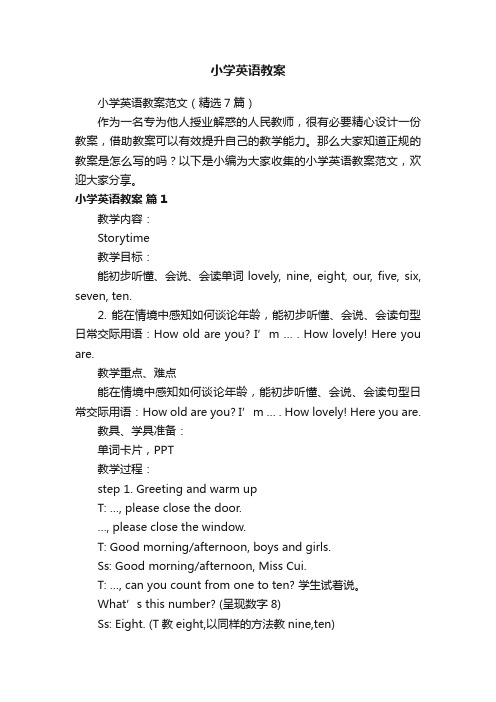
小学英语教案小学英语教案范文(精选7篇)作为一名专为他人授业解惑的人民教师,很有必要精心设计一份教案,借助教案可以有效提升自己的教学能力。
那么大家知道正规的教案是怎么写的吗?以下是小编为大家收集的小学英语教案范文,欢迎大家分享。
小学英语教案篇1教学内容:Storytime教学目标:能初步听懂、会说、会读单词lovely, nine, eight, our, five, six, seven, ten.2. 能在情境中感知如何谈论年龄,能初步听懂、会说、会读句型日常交际用语:How old are you? I’m … . How lovely! Here you are.教学重点、难点能在情境中感知如何谈论年龄,能初步听懂、会说、会读句型日常交际用语:How old are you? I’m … . How lovely! Here you are.教具、学具准备:单词卡片,PPT教学过程:step 1. Greeting and warm upT: …, please close the door.…, please close the window.T: Good morning/afternoon, boys and girls.Ss: Good morning/afternoon, Miss Cui.T: …, can you count from one to ten? 学生试着说。
What’s this number? (呈现数字8)Ss: Eight. (T教eight,以同样的方法教nine,ten)Step 2.Presentation and practice .T:(出示Mike, Helen, Tim的图片)Look, Helen is Mike’s brother. Mike is nine. And how old are you?Ss: I’m eight/nine /ten .新授句型,引导学生问答。
小学英语教学教案优秀7篇
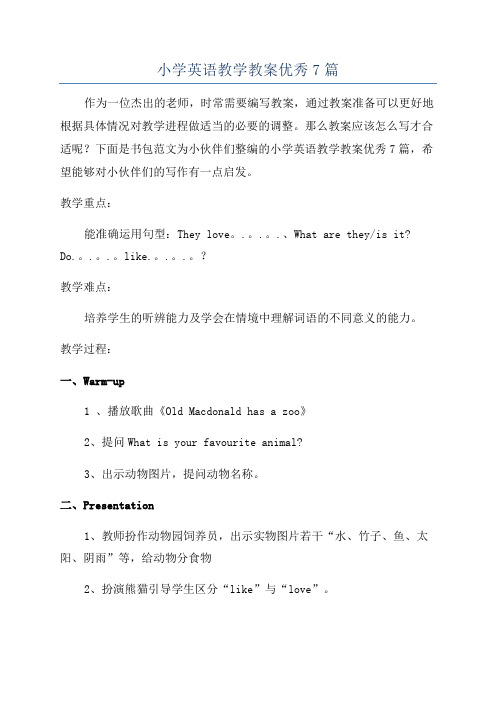
小学英语教学教案优秀7篇作为一位杰出的老师,时常需要编写教案,通过教案准备可以更好地根据具体情况对教学进程做适当的必要的调整。
那么教案应该怎么写才合适呢?下面是书包范文为小伙伴们整编的小学英语教学教案优秀7篇,希望能够对小伙伴们的写作有一点启发。
教学重点:能准确运用句型:They love。
.。
.。
.、What are they/is it? Do.。
.。
.。
like.。
.。
.。
?教学难点:培养学生的听辨能力及学会在情境中理解词语的不同意义的能力。
教学过程:一、Warm-up1 、播放歌曲《Old Macdonald has a zoo》2、提问What is your favourite animal?3、出示动物图片,提问动物名称。
二、Presentation1、教师扮作动物园饲养员,出示实物图片若干“水、竹子、鱼、太阳、阴雨”等,给动物分食物2、扮演熊猫引导学生区分“like”与“love”。
3、出示天气图片,通过对天气的喜爱程度,引导学生运用“like”与“love”。
三、Practice1、听活动一录音完成动物特征和喜好表格。
2、依据表格进行谜语创作。
四、Consolidation1、播放录音,让学生体会语调。
2、引导学生小组设计一组就动物习性进行的谈话,用准确的语调展示。
五、Summary引导学生整理本模块内容,介绍所学内容。
板书设计:Module7 Unit2 Pandas love bamboo。
Snakes love the sun。
What are they? Elephants like the water.They are.。
.。
.。
Pandas love bamboo.Dogs play with children.Cats like fish.一、设多彩情景,创课堂氛围众所周知,英语是一种语言,而非一般的知识。
语言的学习如果脱离了一定的情境,学生学习起来不但吃力,更不能很好地把握知识的用法。
小学英语教案说课稿(优秀6篇)
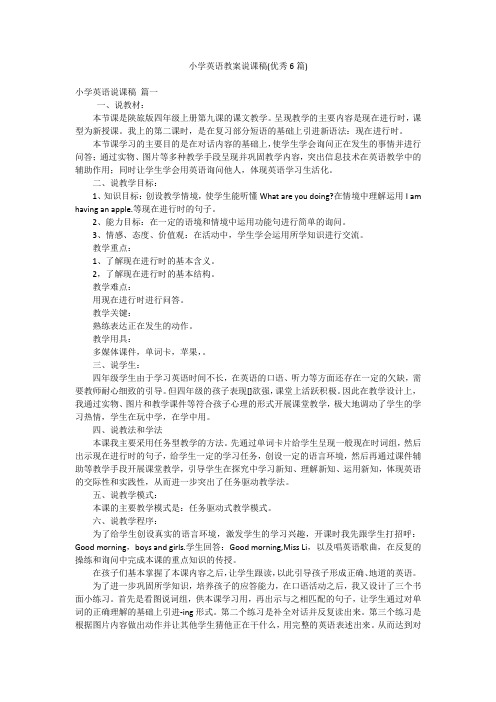
小学英语教案说课稿(优秀6篇)小学英语说课稿篇一一、说教材:本节课是陕旅版四年级上册第九课的课文教学。
呈现教学的主要内容是现在进行时,课型为新授课。
我上的第二课时,是在复习部分短语的基础上引进新语法:现在进行时。
本节课学习的主要目的是在对话内容的基础上,使学生学会询问正在发生的事情并进行问答;通过实物、图片等多种教学手段呈现并巩固教学内容,突出信息技术在英语教学中的辅助作用;同时让学生学会用英语询问他人,体现英语学习生活化。
二、说教学目标:1、知识目标:创设教学情境,使学生能听懂What are you doing?在情境中理解运用I am having an apple.等现在进行时的句子。
2、能力目标:在一定的语境和情境中运用功能句进行简单的询问。
3、情感、态度、价值观:在活动中,学生学会运用所学知识进行交流。
教学重点:1、了解现在进行时的基本含义。
2,了解现在进行时的基本结构。
教学难点:用现在进行时进行问答。
教学关键:熟练表达正在发生的动作。
教学用具:多媒体课件,单词卡,苹果,。
三、说学生:四年级学生由于学习英语时间不长,在英语的口语、听力等方面还存在一定的欠缺,需要教师耐心细致的引导。
但四年级的孩子表现[]欲强,课堂上活跃积极。
因此在教学设计上,我通过实物、图片和教学课件等符合孩子心理的形式开展课堂教学,极大地调动了学生的学习热情,学生在玩中学,在学中用。
四、说教法和学法本课我主要采用任务型教学的方法。
先通过单词卡片给学生呈现一般现在时词组,然后出示现在进行时的句子,给学生一定的学习任务,创设一定的语言环境,然后再通过课件辅助等教学手段开展课堂教学,引导学生在探究中学习新知、理解新知、运用新知,体现英语的交际性和实践性,从而进一步突出了任务驱动教学法。
五、说教学模式:本课的主要教学模式是:任务驱动式教学模式。
六、说教学程序:为了给学生创设真实的语言环境,激发学生的学习兴趣,开课时我先跟学生打招呼:Good morning,boys and girls.学生回答:Good morning,Miss Li,以及唱英语歌曲,在反复的操练和询问中完成本课的重点知识的传授。
小学英语优秀教案(精选5篇)

小学英语优秀教案(精选5篇)英语教案设计是改善课堂教学的一种更高层次的探索,是提高课堂教学质量和效率的一项必要工作。
牛牛范文为您带来了5篇小学英语优秀教案,希望朋友们参阅后能够文思泉涌。
小学一年级英语教案篇一教学目标1、能听说认读四会单词:family parents uncle aunt baby brother cousin 。
2、能用英语简单介绍自己的家庭。
3、了解英语国家中家庭成员之间的称呼习俗。
教学重难点听说认读四会单词:family parents uncle aunt baby brother cousin 。
能用英语简单介绍自己的家庭。
教学过程(一)Warm-up1.GreetingsT: Hello. How are you?Ss: I’m fine, thank you. And you?T: I am fine ,too. Thanks. Are you happy today?Ss: Yes, we are. ,,2.Sing a song: Finger Father(二)Presentation1、出示p p t课件:Look, this is Ding ding’s family 。
Let’s go and meet her family. 教学family Family is means :father and mother I love you (渗透情感教育)2、出示幻灯:(丁丁的全家福)生依次复习人物名称,顺势引出baby brother. 读法:拆分法、组组读3、T: Guess. Who are they?Ss: They’re Ding ding’s father and mother.T: Yes, they are Ding ding ‘s parents. 教学parents (注意复数形式)4、出示幻灯教学Ding ding:I have other families 。
小学英语教案20篇英文版

小学英语教案20篇英文版小学英语教学是教育的基础,也是每一个孩子学习英语的开端。
为了帮助小学英语老师更好地开展教学工作,提高孩子的英语学习成绩,以下是20篇小学英语教案的英文版,供广大小学英语教师参考。
1. Title: Introducing MyselfContent: Students learn to introduce themselves in English.Objectives: By the end of the class, students should be able to introduce themselves inEnglish.Materials: PPT, pictures, handoutsProcedure:1. Warm-up: Greeting students and asking them about their names.2. Presentation: Using pictures to introduce oneself and providing examples.3. Practice: Students practice introducing themselves in pairs.4. Production: Students present themselves in front of the class.5. Evaluation: Checking students’ pronunciation and fluency.2. Title: ColorsContent: Students learn how to recognize and say different colors in English.Objectives: By the end of the class, students should be able to recognize and name different colors in English.Materials: PPT, flashcards, handoutsProcedure:1.Warm-up: Using colored flashcards to engage students.2. Presentation: Using PPT to show pictures of different colors and their names.3. Practice: Students match the colors with their names and practice saying them.4. Production: Students createtheir own pictures and describe them in English.5. Evaluation: Checking students’ ability to recognize and name different colors.3. Title: NumbersContent: Students learn how to recognize and say the numbers from 1 to 20 in English.Objectives: By the end of the class, students should be able to recognize and say the numbers from 1 to 20 in English.Materials: PPT, flashcards, handoutsProcedure:1. Warm-up: Using number flashcards to engage students.2. Presentation: Using PPT to show pictures of the numbers from 1 to 20 and their names.3. Practice: Students match the numbers with their names and practice saying them.4. Production: Students practice counting in English and count the number of objects in the classroom.5. Evaluation: Checking students’ ability to recognize and say the numbers from 1 to 20.4. Title: ShapesContent: Students learn how to recognize and name different shapes in English.Objectives: By the end of the class, students should be able to recognize and name different shapes in English.Materials: PPT, flashcards, handoutsProcedure:1. Warm-up: Using shape flashcards to engage students.2. Presentation: Using PPT to show pictures of different shapes and their names.3. Practice: Students match the shapes with their names and practice saying them.4. Production: Students create their own pictures using different shapes and describe them in English.5. Evaluation: Checki ng students’ ability to recognize and name different shapes.5. Title: FamilyContent: Students learn how to talk about their family members in English.Objectives: By the end of the class, students should be able to talk about their family members in English.Materials: PPT, flashcards, handoutsProcedure:1.Warm-up: Asking students about their family members.2. Presentation: Using PPT to show pictures of different family members and their names.3. Practice: Students practice talking about their family members in pairs.4. Production: Students present their family members in front of the class.5. Evaluation: Checking students’ ability to talk about their family members in English.6. Title: AnimalsContent: Students learn how to recognize and name different animals in English.Objectives: By the end of the class, students should be able to recognize and name different animals in English.Materials: PPT, flashcards, handoutsProcedure:1. Warm-up: Using animal flashcards to engage students.2. Presentation: Using PPT to show pictures of different animals and their names.3. Practice: Students match the animals with their names and practice saying them.4. Production: Students create their own pictures using different animals and describe them in English.5. Evaluation: Chec king students’ ability to recognize and name different animals.7. Title: WeatherContent: Students learn how to recognize and name different types of weather in English.Objectives: By the end of the class, students should be able to recognize and name different types of weather in English.Materials: PPT, flashcards,handoutsProcedure:1. Warm-up: Asking students about the weather outside.2. Presentation: Using PPT to show pictures of different types of weather and their names.3. Practice: Students practice recognizing and naming different types of weather.4. Production: Students describe the weather in a particular place.5. Evaluation: Checking students’ ability to recognize and name different types of weather.8. Title: Food and DrinksContent: Students learn how to recognize and name different types of food and drinks in English.Objectives: By the end of the class, students should be able to recognize and name different types of food and drinks in English.Materials: PPT, flashcards, handoutsProcedure:1.Warm-up: Asking students about their favorite food and drinks.2. Presentation: Using PPT to show pictures of different types of food and drinks and their names.3. Practice: Students practice recognizing and naming different types of food and drinks.4. Production: Students decide on a menu and describe the food and drinks in English.5. Evaluation: Checking students’ ability to recognize and name different types of food and drinks.9. Title: My BodyContent: Students learn how to recognize and name different parts of the body in English.Objectives: By the end of the class, students should be able to recognize and name different parts of the body in English.Materials: PPT, flashcards, handoutsProcedure:1. Warm-up: Asking students about different parts of the body.2. Presentation: Using PPT to show pictures of different parts of the body and their names.3. Practice: Studentspractice recognizing and naming different parts of the body.4. Production: Students draw a person and label the different parts of the body in Eng lish.5. Evaluation: Checking students’ ability to recognize and name different parts of the body.10. Title: JobsContent: Students learn how to recognize and name different types of jobs in English.Objectives: By the end of the class, students should be able to recognize and name different types of jobs in English.Materials: PPT, flashcards, handoutsProcedure:1. Warm-up: Asking students about their dream job.2. Presentation: Using PPT to show pictures of different types of jobs and their names.3. Practice: Students practice recognizing and naming different types of jobs.4. Production: Students choose a job and describe it in English.5. Evaluation: Checking students’ ability to recognize and name different types of jobs.11. Title: Days of the WeekContent: Students learn how to recognize and say the days of the week in English.Objectives: By the end of the class, students should be able to recognize and say the days of the week in English.Materials: PPT, flashcards, handoutsProcedure:1. Warm-up: Asking students about their favorite day of the week.2. Presentation: Using PPT to show pictures of the days of the week and their names.3. Practice: Students practice recognizing and saying the days of the week.4. Production: Students describe their schedule for the week.5. Evaluation: Checking students’ ability to recognize and say the days of the week.12. Title: Months of the YearContent: Students learn how to recognize and say the months of the year in English.Objectives: By the end of the class, students should be able to recognize and say the months of the year in English.Materials: PPT, flashcards, handoutsProcedure:1. Warm-up: Asking students about their favorite month of the year.2. Presentation: Using PPT to show pictures of the months of the year and their names.3. Practice: Students practice recognizing and saying the months of the year.4. Production: Students describe their favorite season and the months that belong to it.5. Evaluation: Checking students’ ability to recognize and say the months of the year.13. Title: TimeContent: Students learn how to tell the time in English.Objectives: By the end of the class, students should be able to tell the time in English.Materials: PPT, flashcards, handoutsProcedure:1. Warm-up: Asking students about their favorite time of the day.2. Presentation: Using PPT to show pictures of the clock and different times.3. Practice: Students practice telling the time in English.4. Production: Students plan their daily schedule and write it in English.5. Evaluation: Checking students’ ability to tell the time in English.14. Title: Weather ForecastContent: Students learn how to give a weather forecast in English.Objectives: By the end of the class, students should be able to give a weather forecast in English.Materials: PPT, flashcards, handoutsProcedure:1.Warm-up: Asking students about the weather outside.2. Presentation: Using PPT to show different weather conditions andvocabulary.3. Practice: Students practice giving a weather forecast in pairs.4. Production: Students give a weather forecast in front of the class.5. Evaluation: Checking students’ ability to give a weather forecast in English.15. Title: SeasonsContent: Students learn how to recognize and name the different seasons in English.Objectives: By the end of the class, students should be able to recognize and name the different seasons in English.Materials: PPT, flashcards, handoutsProcedure:1. Warm-up: Asking students about their favorite season.2. Presentation: Using PPT to show pictures of the different seasons and their names.3. Practice: Students practice recognizing and naming the different seasons.4. Production: Students write a paragraph about their favorite season in English.5. Evaluation: Checking students’ ability to recognize and name the different seasons in English.16. Title: ToysContent: Students learn how to recognize and name different types of toys in English.Objectives: By the end of the class, students should be able to recognize and name different types of toys in English.Materials: PPT, flashcards, handoutsProcedure:1. Warm-up: Asking students about their favorite toy.2. Presentation: Using PPT to show pictures of different types of toys and their names.3. Practice: Students practice recognizing and naming different types of toys.4. Production: Students describe their favorite toy in English.5. Evaluation: Checking students’ ability to recognize and name different types of toys.17. Title: School SuppliesContent: Students learn how to recognize and name different school supplies in English.Objectives: By the end of the class, students should be able to recognize and name different school supplies in English.Materials: PPT, flashcards, handoutsProcedure:1. Warm-up: Asking students about their favorite school supply.2. Presentation: Using PPT to show pictures of different school supplies and their names.3. Practice: Students practice recognizing and naming different school supplies.4. Production: Students describe the contents of their school bag in English.5. Evaluation: Checking students’ ability to recognize and name different school supplies.18. Title: Parts of a HouseContent: Students learn how to recognize and name different parts of a house inEnglish.Objectives: By the end of the class, students should be able to recognize and name different parts of a house in English.Materials: PPT, flashcards, handoutsProcedure:1.Warm-up: Asking students about the different rooms in their house.2. Presentation: Using PPT to show pictures of different parts of a house and their names.3. Practice: Students practice recognizing and naming different parts of a house.4. Production: Students describe their favorite room in their house in English.5. Evaluation: Checking students’ ability to recognize and name different parts of a house.19. Title: HolidaysContent: Students learn how to recognize and name different holidays in English.Objectives: By the end of the class, students should be able to recognize and name differentholidays in English.Materials: PPT, flashcards, handoutsProcedure:1. Warm-up: Asking students about their favorite holiday.2. Presentation: Using PPT to show pictures of different holidays and their names.3. Practice: Students practice recognizing and naming different holidays.4. Production: Students write about their favorite holiday in English.5. Evaluation: Checking students’ ability to recognize and name different holidays in English.20. Title: SportsContent: Students learn how to recognize and name different sports in English.Objectives: By the end of the class, students should be able to recognize and name different sports in English.Materials: PPT, flashcards, handoutsProcedure:1. Warm-up: Asking students about their favorite sport.2. Presentation: Using PPT to show pictures of different sports and their names.3. Practice: Students practice recognizing and naming different sports.4. Production: Students describe their favorite sport in English.5. Evaluation: Checking students’ ability to recognize and name different sports in English.以上是20篇小学英语教案的英文版,它们覆盖了小学英语教学的各个方面。
小学英语课程教案范文七篇

小学英语课程教案范文七篇小学英语课程教案范文(精选篇1)活动目标1、让幼儿学会新词:蘑菇、木耳、竹笋。
2、温习学过单词:游泳、医生。
3、感受与陌生人交往的乐趣;学会关心他人。
活动准备1、面具、漂亮的大袋子一个。
2、很多小蘑菇、木耳、竹笋的图片。
3、有森林、篱笆、小河等图片的PPT。
活动过程1、师:孩子们老师今天有些不舒服,今天就由一位新朋友与你们一起,好吗?hello kids,I am sorry to say I have a cold today ,so I need to restfora while, so today you will have a new fri and play with you ,ok?2、魔术师进场。
hello boysand girls.I am a .magician.I will take you a journey, Would you like it?拿出魔法袋,把孩子带进一片森林。
3、走进森林,同时进行warning up.4、Warning up魔术师:来,让我们伸个懒腰,晒晒太阳,闻一闻花香,跳过小篱笆,来到一条河前,游游泳,游啊游,游啊游,然后上岸,拧拧衣服,跺剁腿。
OK,继续前进。
5、魔术师带领孩子们来到一片蘑菇地里。
引导孩子们认识蘑菇mushroom.,学习蘑菇的新单词。
然后让孩子们摘蘑菇,一边摘一边念。
“一朵蘑菇,两朵蘑菇……”然后问几个孩子,“你摘了几朵蘑菇?”6、继续前进。
又看见树木上长着木耳。
学习过程同上。
7、摘完木耳看见竹笋。
学习过程同上。
8、然后问孩子们喜欢什么,喜欢什么就去摘什么,给孩子们一分钟摘蔬菜。
一边摘一边念己摘的是什么。
9、然后说“孩子们,你们的老师还在学校呢,我们回去看看她好不好?”回到教室。
10、今天我们摘了那么多蔬菜,咱们老师又病了,让我们一起把新鲜的蔬菜做一道菜给她吃好不好?于是大家一起炒菜。
wow,mis wang is still atrisk ,howaboutLet usmake lunch for her hand with our vegetables?11、一边炒,一边练习所学的单词。
小学英语教案优秀范文三篇_2020优秀英语教案范文
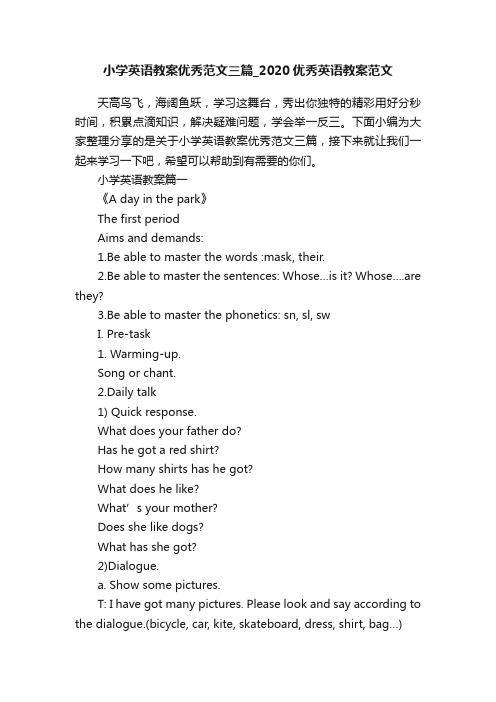
小学英语教案优秀范文三篇_2020优秀英语教案范文天高鸟飞,海阔鱼跃,学习这舞台,秀出你独特的精彩用好分秒时间,积累点滴知识,解决疑难问题,学会举一反三。
下面小编为大家整理分享的是关于小学英语教案优秀范文三篇,接下来就让我们一起来学习一下吧,希望可以帮助到有需要的你们。
小学英语教案篇一《A day in the park》The first periodAims and demands:1.Be able to master the words :mask, their.2.Be able to master the sentences: Whose…is it? Whose….are they?3.Be able to master the phonetics: sn, sl, swI. Pre-task1. Warming-up.Song or chant.2.Daily talk1) Quick response.What does your father do?Has he got a red shirt?How many shirts has he got?What does he like?What’s your mother?Does she like dogs?What has she got?2)Dialogue.a. Show some pictures.T: I have got many pictures. Please look and say according to the dialogue.(bicycle, car, kite, skateboard, dress, shirt, bag…)--- What does your father do? ---He is a dentist.--- Has he got a shirt? ---Yes.---Is this his shirt? ---No, his shirt is red.---Whose shirt is it? ---It’s my brother’s.1. Revision.1) Say the plural nouns.(上面的图片)2) Read and choose the correct words, then read it.---I have a good friend. (He; His ) name is Tom.----This is my mother. (She; He) is a nurse. (She, Her)hair is long.小学英语教案篇二《They were young》教学目标:1.能熟练朗读过去式的否定形式Wasn’t weren’t2.掌握动词be的过去式的否定用法They weren’t old then.She wasn’t tall then.He wasn’t naughty then.It wasn’t fat then.重点难点:能熟练朗读过去式的否定形式Wasn’t weren’t教具准备:小黑板课件教学过程:自学指导 (一)教师带领学生先复习上节课学过的be的过去式用法,并要求背写Am, is------was are------were教师提问,通过对话引出否定式:T: Were you young then?S1: Yes, I was.T: Were you old then?S1: No, I wasn’t.进一步练习weren’t的用法,教师提示,反复变换主语人称,让学生在变换中掌握过去式的用法。
小学英语教案【优秀7篇】
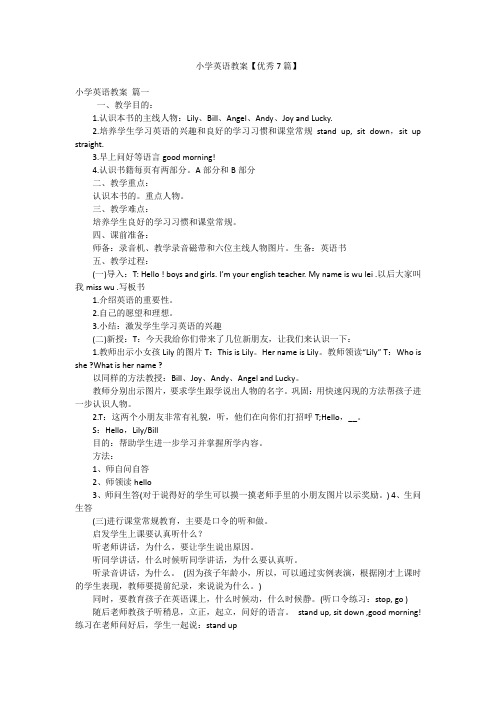
小学英语教案【优秀7篇】小学英语教案篇一一、教学目的:1.认识本书的主线人物:Lily、Bill、Angel、Andy、Joy and Lucky.2.培养学生学习英语的兴趣和良好的学习习惯和课堂常规stand up, sit down,sit up straight.3.早上问好等语言good morning!4.认识书籍每页有两部分。
A部分和B部分二、教学重点:认识本书的。
重点人物。
三、教学难点:培养学生良好的学习习惯和课堂常规。
四、课前准备:师备:录音机、教学录音磁带和六位主线人物图片。
生备:英语书五、教学过程:(一)导入:T: Hello ! boys and girls. I’m your english teacher. My name is wu lei .以后大家叫我miss wu .写板书1.介绍英语的重要性。
2.自己的愿望和理想。
3.小结:激发学生学习英语的兴趣(二)新授:T:今天我给你们带来了几位新朋友,让我们来认识一下:1.教师出示小女孩Lily的图片T:This is Lily。
Her name is Lily。
教师领读“Lily” T:Who is she ?What is her name ?以同样的方法教授:Bill、Joy、Andy、Angel and Lucky。
教师分别出示图片,要求学生跟学说出人物的名字。
巩固:用快速闪现的方法帮孩子进一步认识人物。
2.T:这两个小朋友非常有礼貌,听,他们在向你们打招呼T;Hello,__。
S:Hello,Lily/Bill目的:帮助学生进一步学习并掌握所学内容。
方法:1、师自问自答2、师领读hello3、师问生答(对于说得好的学生可以摸一摸老师手里的小朋友图片以示奖励。
)4、生问生答(三)进行课堂常规教育,主要是口令的听和做。
启发学生上课要认真听什么?听老师讲话,为什么,要让学生说出原因。
听同学讲话,什么时候听同学讲话,为什么要认真听。
小学英语教学案例范文 小学英语课案例(精选8篇)

小学英语教学案例范文小学英语课案例(精选8篇)作为一名默默奉献的教育工作者,有必要进行细致的教案准备工作,教案是教材及大纲与课堂教学的纽带和桥梁。
那么教案应该怎么写才合适呢?作者整理了8篇小学英语教学案例范文小学英语课案例,希望您在阅读之后,能够更好的写作英语教学案例。
英语教学案例篇一我在英语教学过程中尽可能少地说汉语,而是通过手势、眼神、动作、音调等辅助手段来组织教学。
例如:我采用“Let’sbeginmoring(afternoon),class!”来作为一堂课的开场白,而在下课时用“Theclassis-Bye,class!”作为结束语。
在讲课过程中,我提醒学生看黑板时,便会用手指着黑板并说出“Lookattheblackboard.”让学生打开书时,我便会说出“Openyourbook,please.”,同时将双手摊开。
要求学生合上书,我便说“Closeyourbook,please.”并将双手由摊开到合并。
案例分析:小学英语教学要通过听说读写训练帮助学生学会正确的英语发音,具有一定的口头表达能力,它犹如一根主线贯穿整个教学的全过程。
其中,听说训练极为重要,训练的途径也是多样化的。
用英语组织教学能增加学生的语言实践机会,创设英语氛围,培养学生直接用英语思维、表达的习惯。
也许在刚上英语课时,学生听不懂老师的课堂用语,这时,老师配合以一定的动作,来帮助学生明白老师要表达的意思。
接触的时间长了,学生听习惯了,自然而然就会记住老师每句话的意思了。
这样让学生在英语的环境中学习,能增加他们学习英语的兴趣,培养学生的使用英语的良好习惯。
让学生充分感受到英语课堂就是一个英语世界,在这个世界里,可以学到很多的英语知识。
学生与老师之间,可以自由的用英语对话,学生与学生之间,可以用英语表演所学的对话,老师可以把所学的单词,编成英语歌曲,教给学生,让学生顺利的记住所学的单词。
总之,让学生把英语课堂当成一个自由发展的空间,可以自由的遨游于这个英语世界。
小学英语优秀教案模板5篇
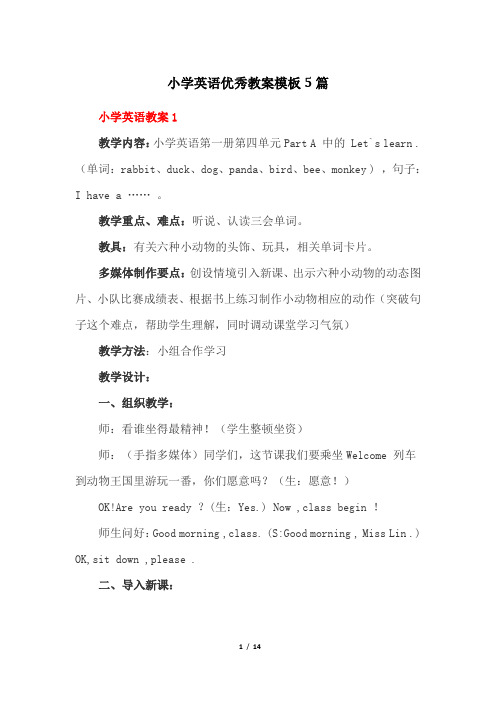
小学英语优秀教案模板5篇小学英语教案1教学内容:小学英语第一册第四单元Part A 中的 Let`s learn .(单词:rabbit、duck、dog、panda、bird、bee、monkey ) ,句子:I have a ……。
教学重点、难点:听说、认读三会单词。
教具:有关六种小动物的头饰、玩具,相关单词卡片。
多媒体制作要点:创设情境引入新课、出示六种小动物的动态图片、小队比赛成绩表、根据书上练习制作小动物相应的动作(突破句子这个难点,帮助学生理解,同时调动课堂学习气氛)教学方法:小组合作学习教学设计:一、组织教学:师:看谁坐得最精神!(学生整顿坐资)师:(手指多媒体)同学们,这节课我们要乘坐Welcome 列车到动物王国里游玩一番,你们愿意吗?(生:愿意!)OK!Are you ready ?(生:Yes.) Now ,class begin !师生问好:Good morning ,class. (S:Good morning , Miss Lin .) OK,sit down ,please .二、导入新课:师:(多媒体展示)同学们看,动物王国的小动物可真淘气,有的露出一只小耳朵,有的露出了一只半截小尾巴,还有的露出了一只小手。
那么你们能猜出它们是谁吗?(学生纷纷举手发言)——猜,是小学生的一大嗜好。
一石激起千层浪,学生的热情被点燃。
师:那让我们来看个究竟吧!(多媒体展示各种小动物的动态图片)——生动有趣的动画效果,激起学生的学习兴趣师:第一个出场的是谁……(在多媒体展示的过程中,学生说出各种小动物,老师借此板贴单词卡片)——结合个别学生课外参加补习班的情况,而这一课的单词又比较常见,很多同学能直接说出这些小动物用英语怎么说。
因此,借此导课。
三、教学单词:1、了解学生知识水平①、师:刚才老师听到有些同学知道这些小动物用英语怎么说,老师可真佩服你。
那么,你能站起来再说一遍吗?——及时鼓励!能说几个就说几个!——让每个学生知道自己很棒,感受成功的喜悦!(生说单词。
小学英语优秀教案设计(5篇)
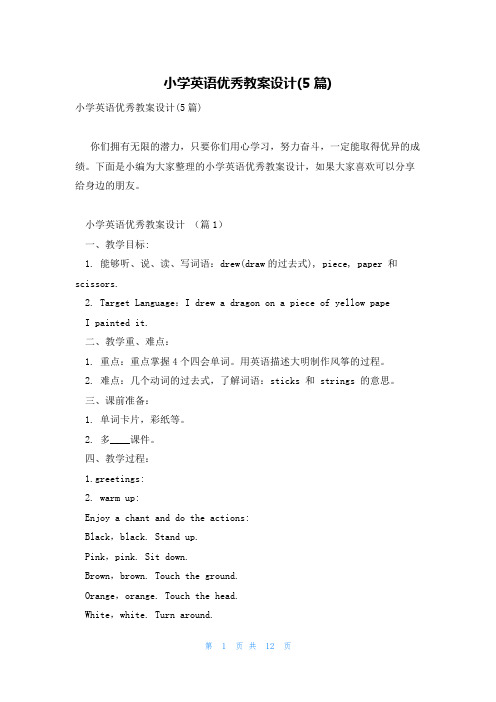
小学英语优秀教案设计(5篇)小学英语优秀教案设计(5篇)你们拥有无限的潜力,只要你们用心学习,努力奋斗,一定能取得优异的成绩。
下面是小编为大家整理的小学英语优秀教案设计,如果大家喜欢可以分享给身边的朋友。
小学英语优秀教案设计(篇1)一、教学目标:1. 能够听、说、读、写词语:drew(draw的过去式), piece, paper 和scissors.2. Target Language:I drew a dragon on a piece of yellow papeI painted it.二、教学重、难点:1. 重点:重点掌握4个四会单词。
用英语描述大明制作风筝的过程。
2. 难点:几个动词的过去式,了解词语:sticks 和 strings 的意思。
三、课前准备:1. 单词卡片,彩纸等。
2. 多____课件。
四、教学过程:1.greetings:2. warm up:Enjoy a chant and do the actions:Black,black. Stand up.Pink,pink. Sit down.Brown,brown. Touch the ground.Orange,orange. Touch the head.White,white. Turn around.(在此活动中同学们利用课前领到的彩纸来配合做动作,既活跃了课堂气氛拉近了师生间的距离,也为后面的教学打下了基础)2. 新词呈现:T: Boys and girls, I have so much colorful paper. Look, a piece of red paper, a piece of yellow paper, and… 引导学生回答a piece of green paper… 接着板书a piece of 并学习,然后让学生利用自己手中的彩纸来练习a piece of yellow/red/green paper等等。
小学英语优秀教案(优秀7篇)
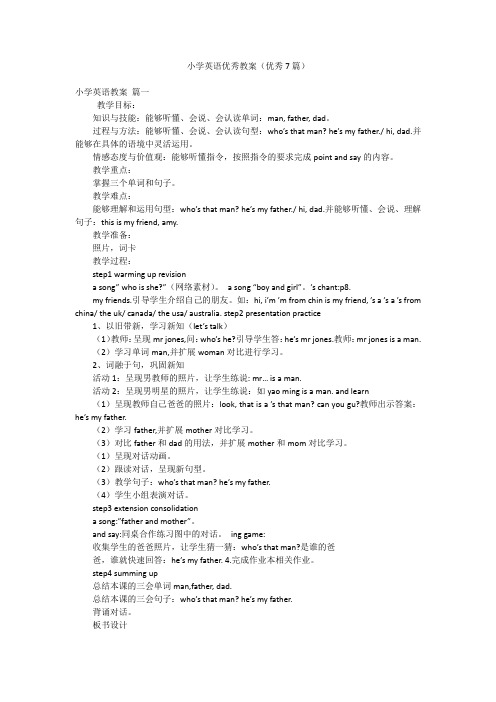
小学英语优秀教案(优秀7篇)小学英语教案篇一教学目标:知识与技能:能够听懂、会说、会认读单词:man, father, dad。
过程与方法:能够听懂、会说、会认读句型:who’s that man? he’s my father./ hi, dad.并能够在具体的语境中灵活运用。
情感态度与价值观:能够听懂指令,按照指令的要求完成point and say的内容。
教学重点:掌握三个单词和句子。
教学难点:能够理解和运用句型:who’s that man? he’s my father./ hi, dad.并能够听懂、会说、理解句子:this is my friend, amy.教学准备:照片,词卡教学过程:step1 warming up revisiona song” who is she?”(网络素材)。
a song “boy and girl”。
’s chant:p8.my friends.引导学生介绍自己的朋友。
如:hi, i’m ’m from chin is my friend, ’s a ’s a ’s from china/ the uk/ canada/ the usa/ australia. step2 presentation practice1、以旧带新,学习新知(let’s talk)(1)教师:呈现mr jones,问:who’s he?引导学生答:he’s mr jones.教师:mr jones is a man.(2)学习单词man,并扩展woman对比进行学习。
2、词融于句,巩固新知活动1:呈现男教师的照片,让学生练说: mr… is a man.活动2:呈现男明星的照片,让学生练说:如yao ming is a man. and learn(1)呈现教师自己爸爸的照片:look, that is a ’s that man? can you gu?教师出示答案:he’s my father.(2)学习father,并扩展mother对比学习。
小学英语教案全英文版(优秀13篇)
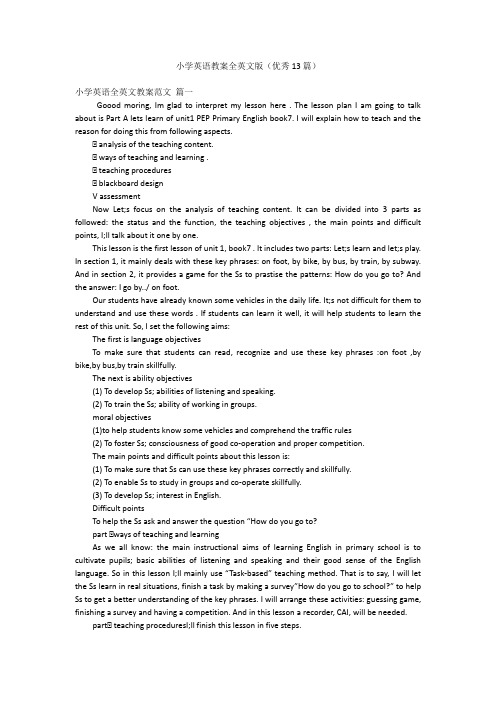
小学英语教案全英文版(优秀13篇)小学英语全英文教案范文篇一Goood moring, Im glad to interpret my lesson here . The lesson plan I am going to talk about is Part A lets learn of unit1 PEP Primary English book7. I will explain how to teach and the reason for doing this from following aspects.Ⅰ analysis of the teaching content.Ⅰ ways of teaching and learning .Ⅰ teaching proceduresⅠ blackboard designV assessmentNow Let;s focus on the analysis of teaching content. It can be divided into 3 parts as followed: the status and the function, the teaching objectives , the main points and difficult points, I;ll talk about it one by one.This lesson is the first lesson of unit 1, book7 . It includes two parts: Let;s learn and let;s play. In section 1, it mainly deals with these key phrases: on foot, by bike, by bus, by train, by subway. And in section 2, it provides a game for the Ss to prastise the patterns: How do you go to? And the answer: I go by../ on foot.Our students have already known some vehicles in the daily life. It;s not difficult for them to understand and use these words . If students can learn it well, it will help students to learn the rest of this unit. So, I set the following aims:The first is language objectivesTo make sure that students can read, recognize and use these key phrases :on foot ,by bike,by bus,by train skillfully.The next is ability objectives(1) To develop Ss; abilities of listening and speaking.(2) To train the Ss; ability of working in groups.moral objectives(1)to help students know some vehicles and comprehend the traffic rules(2) To foster Ss; consciousness of good co-operation and proper competition.The main points and difficult points about this lesson is:(1) To make sure that Ss can use these key phrases correctly and skillfully.(2) To enable Ss to study in groups and co-operate skillfully.(3) To develop Ss; interest in English.Difficult pointsTo help the Ss ask and answer the question “How do you go to?part Ⅰways of teaching and learningAs we all know: the main instructional aims of learning English in primary school is to cultivate pupils; basic abilities of listening and speaking and their good sense of the English language. So in this lesson I;ll mainly use “Task-based” teaching method. That is to say, I will let the Ss learn in real situations, finish a task by making a survey”How do you go to school?” to help Ss to get a better understanding of the key phrases. I will arrange these activities: guessing game, finishing a survey and having a competition. And in this lesson a recorder, CAI, will be needed.partⅠ teaching proceduresI;ll finish this lesson in five steps.step1 lead--in activitiesI will begin my class with drawing and guessing game, just like this : I show students some vehicles such as bike ,bus ,jeep which they learned before by Stick Figures and ask them guess what;s it.Purpose: It is important to form a better English learning surrounding for the Ss by guessing game. and at the same time it provides situations to review learned knowledge for the next step.step2 prestentationNow I;ll mainly talk about this step.1、first there is a Free talk between T and Ss. For example: I show many pictures of beautiful cities and ask students some questions, such as do you like this city?where do you want to go ?and help Ss to answer them with by train ,by plane,by ship.By the way, I show the picture of a school, and say“ I go to schiool by bus” ,Ss read this sentence. do the actions and ask how do you go to school?,show many pictures of tools such as ,on foot by bike ,by bus to help students answer my question one by one.To present the key structures one by one is much easier for the Ss to learn and grasp the meanings.2 With the help of the CAI I set a situation to help Ss understand the way of using these key phrases:A boy is coming, who is going to school. He says: I go to school byThen play the sounds of bus, bike ask students to listen carefully and tell “I go to school by according to the different sounds, by the way , I present another new phrases:by subwayPurpose:Make Ss use these new phrases with sentence structures, to help Ss use the language in a real situation.step3 practise3 I order to make every student read these new phrases correctly, I design a drill in this step,I show cards as soon as possible ,students should read the words quickly and spell them. Then I ask How do you go to school?students answer I go to ......also I will quicken the speed to ask .The purpose is to draw the whole studentsattention to the spelling of the words4 After this, I ask Ss to do Lets play in fours. They use places cards and vehicle cards, ask and answer:How do you go to ? I go to by”5, If Ss can ask and answer expertly, I will ask them to make a short dialogue.the purpose of this is to help students to learn those sentenses through a ture situation and make the dialogues in order to check if Ss can usse these key prases、sentences structures skillfullystep 4 consolidationlet students do a survey about how do you go to school?and the table like this :write down names and tools another Ss chooseTask-based teaching method is used here to develop Ss; ability of ; communication and also their ability of co-operation will be well trained.step 5 homeworkask students to collect other kinds of transport tools through the library ,computer.the purpose of this is to stimulate the interest of learning english and to wide the studentsknowledgestep6 blackboard designmy blackboard design like this :on the left Ishow the phrases:on foot,by bus.......on the right there are many sentences:how do you go to school?I go to ......step 7 assessmentdue to the studentsage ,I make every students work in class through many activities in order to stimulate the studentsinterest and provide they a wide thinking room. I make students learn this lesson very well through desiring scene statuesthats all,thank you for your listening !Unit 1 Lesson 篇二Part A Let;s say, Let;s chant Part C CultureTeaching Aims :1、Be able to listen, say, recognize the words: apple, ant, boy, bag, Coke, coffee.2、Be able to listen, say, read and write these three letters: A a; B b; C c3、Through the chant review the letters of ABC, train a sense of group identity.Focus Points amp; Difficult Points :Read the letters: Big letter C, small letter c; Write down them correctly and handsomely.Teaching Preparation:1、Letter cards ,some word pictures, word cards: apple boy eraser ant crayon body head cake Coke coffee bag ball2、A little blackboard with four-line format and a ball.Designing for the blackboard:panda beaver eagle kangaroo (pictures)China Canada America Australia (words)Teaching Steps:Step1. Warm ndash;up1、Sing a song.2、Free talkT: Hello. I;m Wendy. I;m from Hangzhou.S1: Hello! I;m 。
小学英语优质公开课教案(通用14篇)
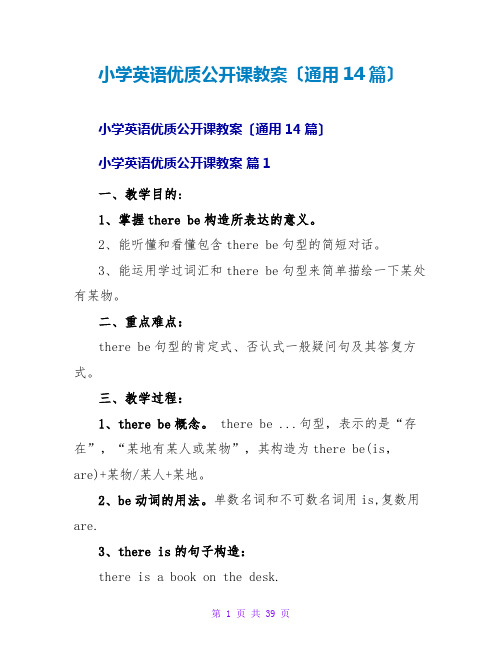
小学英语优质公开课教案〔通用14篇〕小学英语优质公开课教案〔通用14篇〕小学英语优质公开课教案篇1一、教学目的:1、掌握there be构造所表达的意义。
2、能听懂和看懂包含there be句型的简短对话。
3、能运用学过词汇和there be句型来简单描绘一下某处有某物。
二、重点难点:there be句型的肯定式、否认式一般疑问句及其答复方式。
三、教学过程:1、there be概念。
there be ...句型,表示的是“存在”,“某地有某人或某物”,其构造为there be(is,are)+某物/某人+某地。
2、be动词的用法。
单数名词和不可数名词用is,复数用are.3、there is的句子构造:there is a book on the desk.there is some water in the bottle.4、there are的句子构造:there are some pictures on the wall.小学英语优质公开课教案篇2教学目的:1.能听说、认读eye, face , ear, nose, mouth,这些关于身体部位的单词,并能用英语介绍自己身体的这几个局部2.初步理解表示接触的指示用语,能听懂,并按指令做出相应的动作。
3.激发学生学习兴趣,培养听说习惯和才能。
教学重点:关于头部的单词eye, face , ear, nose, mouth的学习。
教学难点:eye, face两个单词的元音因素容易发音不到位,老师可鼓励学生张大口型,互相检查。
mouth一词的尾音发音较难,老师可适当提醒学生,注意口型教学过程:step 1.warm up and revi-sion 1.greetings :hello,boys and girls! nice to meet you! sit down please!step 2.presentation1.利用多媒体展示学生感兴趣的动画人物“大耳朵图图”,让学生与图中人物进展口语交流let’s say “hello, tutu.”2.tu tu is so cute.look! this is tutu’s eye.并指着tutu的眼睛介绍。
小学英语教学案例(5篇)
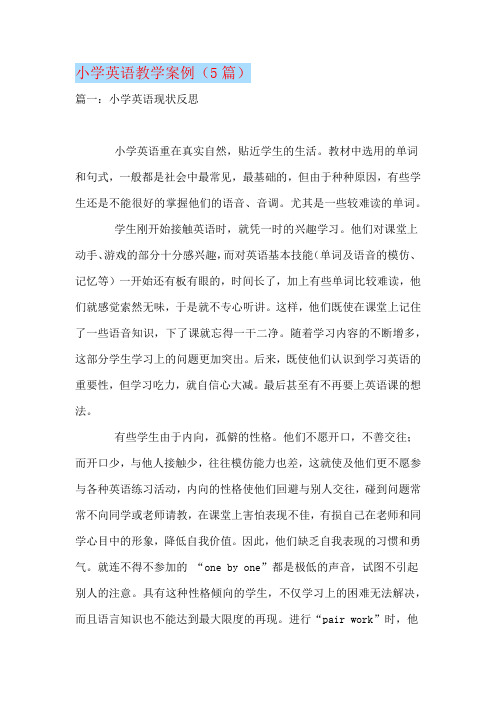
小学英语教学案例(5篇)篇一:小学英语现状反思小学英语重在真实自然,贴近学生的生活。
教材中选用的单词和句式,一般都是社会中最常见,最基础的,但由于种种原因,有些学生还是不能很好的掌握他们的语音、音调。
尤其是一些较难读的单词。
学生刚开始接触英语时,就凭一时的兴趣学习。
他们对课堂上动手、游戏的部分十分感兴趣,而对英语基本技能(单词及语音的模仿、记忆等)一开始还有板有眼的,时间长了,加上有些单词比较难读,他们就感觉索然无味,于是就不专心听讲。
这样,他们既使在课堂上记住了一些语音知识,下了课就忘得一干二净。
随着学习内容的不断增多,这部分学生学习上的问题更加突出。
后来,既使他们认识到学习英语的重要性,但学习吃力,就自信心大减。
最后甚至有不再要上英语课的想法。
有些学生由于内向,孤僻的性格。
他们不愿开口,不善交往;而开口少,与他人接触少,往往模仿能力也差,这就使及他们更不愿参与各种英语练习活动,内向的性格使他们回避与别人交往,碰到问题常常不向同学或老师请教,在课堂上害怕表现不佳,有损自己在老师和同学心目中的形象,降低自我价值。
因此,他们缺乏自我表现的习惯和勇气。
就连不得不参加的“one by one”都是极低的声音,试图不引起别人的注意。
具有这种性格倾向的学生,不仅学习上的困难无法解决,而且语言知识也不能达到最大限度的再现。
进行“pair work”时,他们总是不投入,缺乏跟同学的合作精神。
目前,大部分学生每周只有三节课能接触到英语,加之班额较大,既使在英语课堂上也只有少数优秀的、积极的学生想参与语言实践活动,一堂课上单词、对话或课文等教学内容一项接一项,对于学习能力不强的学生来说犹如看电影似的过了一遍,根本掌握不了。
同时,课后没有很好的语言环境,学生语音掌握更加困难。
由于不知道英语的基本音标,有些学生面对已遗忘的单音节词不知所措,对他们来说,英语单词实在难记,这使英语课成了死记硬背的代名词。
如果教师试图通过大量的练习来巩固学生所学的语言点,就会使教学“机械化”。
小学英语教学案例(精选20篇)
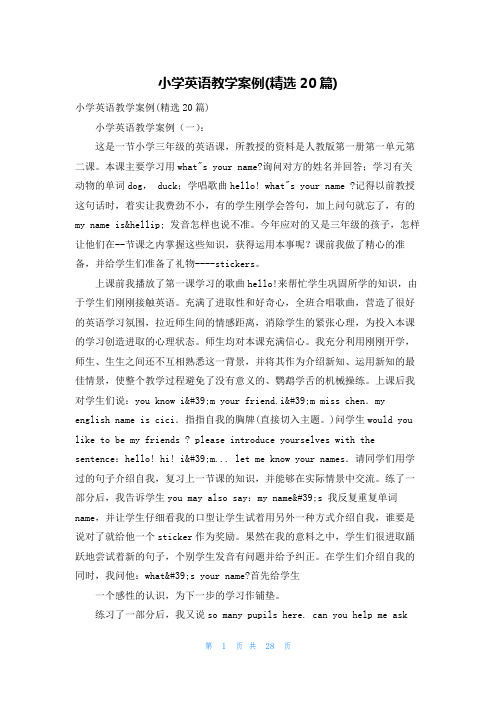
小学英语教学案例(精选20篇)小学英语教学案例(精选20篇)小学英语教学案例(一):这是一节小学三年级的英语课,所教授的资料是人教版第一册第一单元第二课。
本课主要学习用what"s your name?询问对方的姓名并回答;学习有关动物的单词dog, duck;学唱歌曲hello! what"s your name ?记得以前教授这句话时,着实让我费劲不小,有的学生刚学会答句,加上问句就忘了,有的my name is… 发音怎样也说不准。
今年应对的又是三年级的孩子,怎样让他们在--节课之内掌握这些知识,获得运用本事呢?课前我做了精心的准备,并给学生们准备了礼物----stickers。
上课前我播放了第一课学习的歌曲hello!来帮忙学生巩固所学的知识,由于学生们刚刚接触英语。
充满了进取性和好奇心,全班合唱歌曲,营造了很好的英语学习氛围,拉近师生间的情感距离,消除学生的紧张心理,为投入本课的学习创造进取的心理状态。
师生均对本课充满信心。
我充分利用刚刚开学,师生、生生之间还不互相熟悉这一背景,并将其作为介绍新知、运用新知的最佳情景,使整个教学过程避免了没有意义的、鹦鹉学舌的机械操练。
上课后我对学生们说:you know i'm your friend.i'm miss chen.my english name is cici.指指自我的胸牌(直接切入主题。
)问学生would you like to be my friends ? please introduce yourselves with the sentence:hello! hi! i'm... let me know your names.请同学们用学过的句子介绍自我,复习上一节课的知识,并能够在实际情景中交流。
练了一部分后,我告诉学生you may also say:my name's 我反复重复单词name,并让学生仔细看我的口型让学生试着用另外一种方式介绍自我,谁要是说对了就给他一个sticker作为奖励。
小学英语教案(通用20篇)

小学英语教案小学英语教案(通用20篇)作为一名为他人授业解惑的教育工作者,很有必要精心设计一份教案,教案有助于学生理解并掌握系统的知识。
教案应该怎么写才好呢?下面是小编收集整理的小学英语教案,仅供参考,希望能够帮助到大家。
小学英语教案篇1教材分析:在本课时主要学习见面打招呼、自我介绍及道别用语Hello./Hi . Goodbye./Bye-Bye. 为此,教师为学生创设见面打招呼、自我介绍以及道别等情景,使学生了解英语常用用语以及使用环境。
教学中,除让学生听懂以上日常用语以外,还应让学生敢说、会说。
教学目标:1、听懂、会说 Hello./Hi . Goodbye./Bye-Bye.2、通过创设见面打招呼、自我介绍以及道别等情景,让学生学会见面打招呼、自我介绍及道别的日常用语3、培养学生乐于开口,敢于开口讲英语的习惯,激发学生想学、乐学英语的兴趣和愿望。
重点难点:本部分主要是见面打招呼、自我介绍及道别用语的会话学习,使学生在不同的情景中听懂、会说Hello./Hi . Goodbye./Bye-Bye. Im …。
教具准备:1、教师自备与本课教学有关的文具和教师卡片。
2、课件。
教学过程:一、热身、复习(Warm-up/Revision)T: Hello,everyone.Ss: Hello,teacher.T: How are you ,today?Ss: I’m fine,thanks.二、呈现新课(Presentation)(1)Let’s learnA:教师边说边做:Hello./Hi . Goodbye./Bye-Bye.B:对话练习S1: Hello!S2: Hello!S3: Bye bye.S4: Good bye.三、趣味操练(Practice)(1)让学生们在黑板上进行卡片找朋友活动,扩展延伸问候语。
Hello. Hi .Goodbye. Bye-Bye.How are you? I’m fine,thank you.Good morning. Good morning.Nice to meet you. Nice to meet you, too.(2)Chant练习。
小学生英语教案优秀范文_2020英语教案范文文

小学生英语教案优秀范文_2020英语教案范文文芬芳袭人花枝俏,喜气盈门捷报到。
心花怒放看通知,梦想实现今日事,喜笑颜开忆往昔,勤学苦读最美丽。
在学习中学会复习,在运用中培养能力,在总结中不断提高。
下面小编为大家整理分享的是关于小学生英语教案优秀范文,接下来就让我们一起来学习一下吧,希望可以帮助到有需要的你们。
小学英语教案篇一We lived in a small house.教学目标:1、知识目标:(1)New words: life ,different, ago, any, television, grandchildren, us, grandmother, lady(2)New sentences:There were/weren’t …. There are….We lived…many years ago. We live…now.2、能力目标:(1)能根据情境正确使用There be ……,We lived…many years ago. We live…now.句型谈论生活、学习中的事物(2)培养学生听、说、读、写的能力。
教学重点::如何让学生在课堂上学会There be …, We lived…many years ago. We live…now.句型并能在生活中灵活运用该句型。
教学过程:一.预习检测写出下列动词的过去式。
do_____ is____ are_____live_____ have______ watch____二.合作探究,学习课文。
1)播放课文录音,让学生在听录音的同时找出课文中出现的新单词与新句型。
2)进行游戏“火眼金睛找生词新句”。
让学生以竞赛抢答的形式快速找出课文中出现的新单词与新句型。
3)在让学生初步了解了课文内容后,教师再次播放录音,让学生大声跟读课文。
巩固练习;重点句式操练Listen and say。
先让学生听录音,跟读句子,明确本课的重点句式,然后让他们灵活运用句式:There is/are……/There was/were……造句。
小学英语课堂教案优秀范文2020
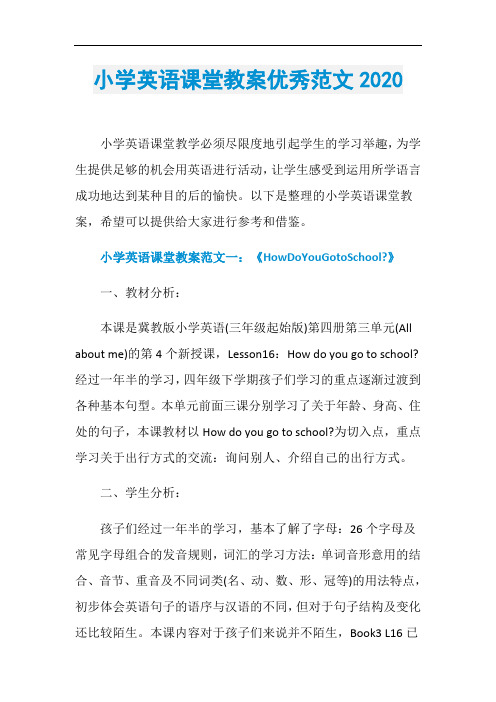
小学英语课堂教案优秀范文2020小学英语课堂教学必须尽限度地引起学生的学习举趣,为学生提供足够的机会用英语进行活动,让学生感受到运用所学语言成功地达到某种目的后的愉快。
以下是整理的小学英语课堂教案,希望可以提供给大家进行参考和借鉴。
小学英语课堂教案范文一:《HowDoYouGotoSchool?》一、教材分析:本课是冀教版小学英语(三年级起始版)第四册第三单元(All about me)的第4个新授课,Lesson16:How do you go to school? 经过一年半的学习,四年级下学期孩子们学习的重点逐渐过渡到各种基本句型。
本单元前面三课分别学习了关于年龄、身高、住处的句子,本课教材以How do you go to school?为切入点,重点学习关于出行方式的交流:询问别人、介绍自己的出行方式。
二、学生分析:孩子们经过一年半的学习,基本了解了字母:26个字母及常见字母组合的发音规则,词汇的学习方法:单词音形意用的结合、音节、重音及不同词类(名、动、数、形、冠等)的用法特点,初步体会英语句子的语序与汉语的不同,但对于句子结构及变化还比较陌生。
本课内容对于孩子们来说并不陌生,Book3 L16已学习过四种出行方式by bus, by car, by bike, by taxi和句子:How do you go to school? I go to school by ____? 另一种出行方式on foot /walk,dives me及选择此种出行方式的原因表述学生相对陌生。
但我校学生学习英语较早,一二年级有了两年的口语学习,还有近1/3有课外学习经历或正在进行,这些内容对于他们可能都不陌生。
基于以上分析,本课时目标制定如下。
三、教学目标:1、知识技能目标:A. 学生能够运用所学句型Do you walk to school? How do you go to school? I go to ___ by___ / on foot...询问、表达适合自己的出行方式。
小学英语教案大全精选_小学生英语教案范文2020
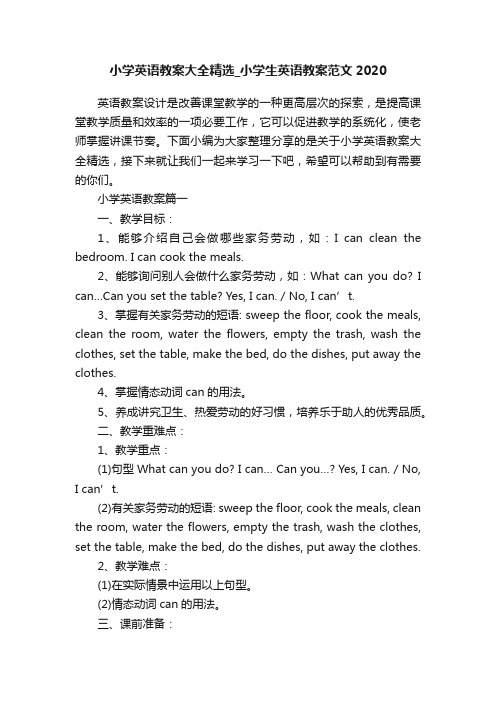
小学英语教案大全精选_小学生英语教案范文2020英语教案设计是改善课堂教学的一种更高层次的探索,是提高课堂教学质量和效率的一项必要工作,它可以促进教学的系统化,使老师掌握讲课节奏。
下面小编为大家整理分享的是关于小学英语教案大全精选,接下来就让我们一起来学习一下吧,希望可以帮助到有需要的你们。
小学英语教案篇一一、教学目标:1、能够介绍自己会做哪些家务劳动,如:I can clean the bedroom. I can cook the meals.2、能够询问别人会做什么家务劳动,如:What can you do? I can…Can you set the table? Yes, I can. / No, I can’t.3、掌握有关家务劳动的短语: sweep the floor, cook the meals, clean the room, water the flowers, empty the trash, wash the clothes, set the table, make the bed, do the dishes, put away the clothes.4、掌握情态动词can的用法。
5、养成讲究卫生、热爱劳动的好习惯,培养乐于助人的优秀品质。
二、教学重难点:1、教学重点:(1)句型What can you do? I can… Can you…? Yes, I can. / No,I can’t.(2)有关家务劳动的短语: sweep the floor, cook the meals, clean the room, water the flowers, empty the trash, wash the clothes, set the table, make the bed, do the dishes, put away the clothes.2、教学难点:(1)在实际情景中运用以上句型。
- 1、下载文档前请自行甄别文档内容的完整性,平台不提供额外的编辑、内容补充、找答案等附加服务。
- 2、"仅部分预览"的文档,不可在线预览部分如存在完整性等问题,可反馈申请退款(可完整预览的文档不适用该条件!)。
- 3、如文档侵犯您的权益,请联系客服反馈,我们会尽快为您处理(人工客服工作时间:9:00-18:30)。
小学英语课堂教案优秀范文2020小学英语课堂教案范文一:《HowDoYouGotoSchool?》一、教材分析:本课是冀教版小学英语(三年级起始版)第四册第三单元(All about me)的第4个新授课,Lesson16:How do you go toschool? 经过一年半的学习,四年级下学期孩子们学习的重点逐渐过渡到各种基本句型。
本单元前面三课分别学习了关于年龄、身高、住处的句子,本课教材以How doyou go to school?为切入点,重点学习关于出行方式的交流:询问别人、介绍自己的出行方式。
二、学生分析:孩子们经过一年半的学习,基本了解了字母:26个字母及常见字母组合的发音规则,词汇的学习方法:单词音形意用的结合、音节、重音及不同词类(名、动、数、形、冠等)的用法特点,初步体会英语句子的语序与汉语的不同,但对于句子结构及变化还比较陌生。
本课内容对于孩子们来说并不陌生,Book3L16已学习过四种出行方式by bus, by car, by bike, by taxi和句子:How do you go to school? I goto school by ____? 另一种出行方式on foot /walk,divesme及选择此种出行方式的原因表述学生相对陌生。
但我校学生学习英语较早,一二年级有了两年的口语学习,还有近1/3有课外学习经历或正在进行,这些内容对于他们可能都不陌生。
基于以上分析,本课时目标制定如下。
三、教学目标:1、知识技能目标:A. 学生能够运用所学句型Do you walk to school? How do you go to school?I go to ___by___ / on foot...询问、表达适合自己的出行方式。
B. 学生知道句子的变化是和人称有关系的,并能尝试运用所学句子介绍和询问他人的出行方式:Does he/she walk to school? Howdooes he/she go to school? He/she goes to school by___ / on foot... 2、文化目标:尝试了解不同地区人们选择不同出行方式:山区孩子、牧民(草原)、江南居民及西方国家等。
3、学习策略目标:学生知道句子的变化是有规律可循的,并引导尝试找出这些规律: A.和人称变化的关系; B.不同句式之间的关系等。
初步构建“单词——短语——句子”的建构学习模式。
4.情感态度目标:通过寻找句子规律及了解不同人们的出行方式,引导学生体会英语学习是有规律可循的,Englishi is easy! 及交流开阔自己的眼界Englishis fun!四、教学重难点:1、教学重点:学生能够运用所学句型Do you walk to school? How do you go to school? I go to___ by___ / on foot...询问、表达适合自己的出行方式。
2、教学难点:学生知道句子的变化是和人称有关系的,并能尝试运用所学句子介绍和询问他人的出行方式:Does he/she walk to school?How does he/she go to school? He/she goes to school by___ / on foot...五、预习作业:(Choose1. Read N1 and fill in the blanks.(☆☆☆☆)How do they go to school? Why?(为什么)KimJennyStevenDannyme 2. Where do you live ? Is it far or near your school?Do you walk tosch ool?(☆☆☆)3. Where do you like to go on weekends? 3 s entences. (☆☆☆)六、教学过程:略小学英语课堂教案范文二:《Funtime&Cartoontime》教学目标<基础性目标>1.能听懂、能理解、会读cartoon time课文。
2.能听懂、会说、会读单词go to school, have lunch, go home, have dinner, go to bed3.能听说、理解、会读句型:When do you get up/…?I usually… at… .<提高性目标>1.能大声流利地朗读课文,并尝试进行文本角色表演。
2.能用英语简单介绍自己一天的生活。
教学重难点1. 能听懂、能理解、会读课文。
2. 能用英语表述文中人物一天的生活。
教学准备教学光盘单词卡教学过程Step1 warming up1. Greetings and free talkWhat day is it? What lessons do we have this morning? What subject do youlike this afternoon?2. Play a gameI like English. It’s funny. Because we can play games at English lessons.Now, it’s game time.快速闪现本课的时间类in the morning和动作类get up等单词,闪现动作做动作, 出现时间就大声读出词组。
Step2. Revision1.(接上步最后一幅图)T: We know, Mike goes to bed at nine o’clock every day. Whendoes he do the other things? Let’s interview him. I’m the reporter. If you wereMike, could you accept my interview?Reporter:Hello, Mike. When do you get up?Mike : I get up at seven.…2. Retell the textT: We’ve known Mike’s day clearly. Could you choose his morning, afternoonor evening, then add your action to retell out?生任选一个时间段,配以动作进行文本复述。
Step3 PresentationFun time1. Draw and writeT: Just now, I’ve been the reporter and we knew a lot about Mike’s day. Doyou want to be the reporter to interview your partner? First draw and write yourtimetable on your book, then ask and answer in pairs.A: Hello, …. W hen do you …?B: I…at …. What about you?A: I…at ….B: Oh, I see.2. Ask and answer ------Miss Huang’s dayT: Oh, you’ve known about your partner’s day. Would you like to interviewme and know about mine?生问问题时,呈现Miss Huang’s dayT: I usually get up at six thirty in the morning. I have breakfast at seveno’clock.At eleven, I have lunch at school. In the afternoon, I read books at twoforty.I have dinner at five every day. Then I watch TV at seven thirty and go toat ten at night.Drill:at night 在夜里3. Contribution time好消息!学校英语角本周征文活动开始了!同学们可将自己的小短文投稿了!生将第一课时的写作练习稍作修改后进行投稿评选。
Cartoon time1. Watch and answer 呈现学习目标1——看动画初步感知课文T:Just now, we talked abou t our days. I have dinner at 5:00. …has dinner at…. Do you know when doe s Bobby have dinner every day? At six? At Seven? Pleasewatch the cartoon and find the answer.初步观看动画、感知课文并验证答案2. Read and answer 呈现学习目标2——读课文,深入理解课文T: Is this story funny? Where is funny?在学生讲述故事笑点的同时,从整体上把握课文,读懂课文Drill: What can you see over there?3. Read after the tape4. Tasks 学生根据自己的实际水平,选择性的完成tasksTask1 Read in roles ★★★Task2 Dub for the roles ★★★★Task3 Act out in groups ★★★★★Song timeT: What a pity! Bobby can’t eat the cake. He should get up. Let’s enjoy thesong“ when do you get up”Step 4 SummaryStep 5 Homework1. 听录音熟读课文,练习背诵。
★2. 结合自己的时间表,用英语介绍自己一天的生活,说给父母朋友听。
★★ Bb designUnit 3 My dayAB教后反思:小学英语课堂教学必须尽限度地引起学生的学习举趣,为学生提供足够的机会用英语进行活动,让学生感受到运用所学语言成功地达到某种目的后的愉快。
为使学生能够在40分钟的时间内保持良好的学习状态,我努力做到教学情景化,从游戏、采访、表演、动画到歌曲的欣赏,尽量调动他们学习积极性,使其更自觉、更有趣的进行英语交际活动。
